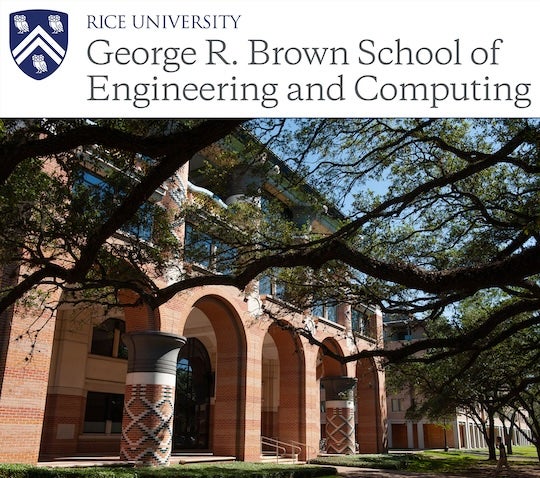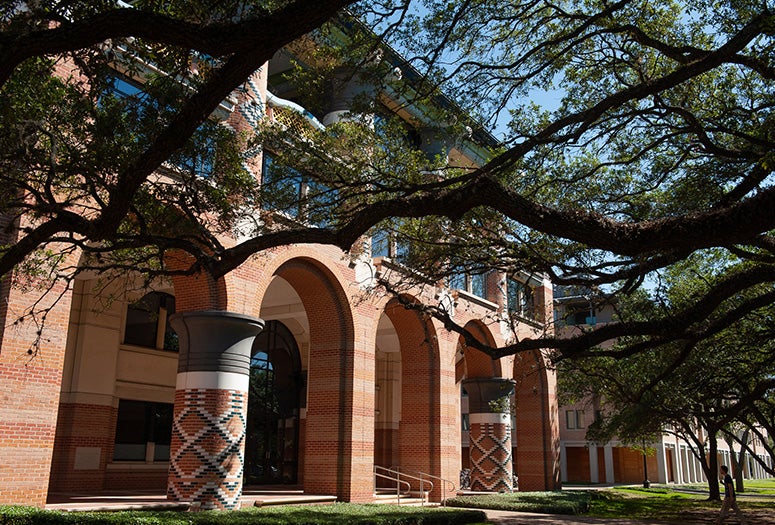In recognition of the transformative impact and historic momentum of computing ⎯ and as a reflection of its record of excellence in the field ⎯ Rice University’s school of engineering has officially changed its name to the George R. Brown School of Engineering and Computing.

“We are in the midst of a historic transformation driven by advances in computing and artificial intelligence, and Rice has the resources, talent and vision to lead the development and application of responsible AI,” said Amy Dittmar, the Howard R. Hughes Provost and executive vice president for academic affairs. “The George R. Brown School of Engineering and Computing will play a key role in ensuring that AI is used responsibly to benefit society and build solutions to challenges in sustainable energy, health care and urban living.”
“Our decision to rename the school to the George R. Brown School of Engineering and Computing reflects the crucial role computing plays today, its expanding importance for the future and our school’s distinguished achievements in this field,” said Luay Nakhleh, the William and Stephanie Sick Dean of Engineering and professor of computer science and biosciences. “Our school is committed to solving for greater good by developing solutions to humanity’s most pressing challenges.
“We harness computing power to develop solutions across various domains, from public health and climate change to designing new materials and building resilient, adaptive communities. This focus on computing is why future computing is one of the five research thrusts of the school’s strategic plan.”
In addition to future computing, the school’s other strategic focus areas are health and well-being, energy and sustainability, resilient and adaptive communities and advanced materials. Computing labs at Rice are working to deploy AI and machine learning as part of a broad range of applied, real-world goals in the five research focus areas across all nine departments.
The George R. Brown School of Engineering and Computing has a rich history of pioneering advancements in computing research with expertise spanning high-performance computing, digital signal processing, computer systems, AI, programming languages and computational optimization. Interdisciplinary research at the intersection of computing and other fields such as engineering, science and health care is thriving across all engineering departments. Additionally, the school has been at the forefront of innovative computing curricula and online education and is ranked among the top 30 engineering schools in the country.
Both the university and the school have made significant investments in computing in recent years. Notable initiatives include the commitment in 2019 to double the size of the computer science department and expand faculty hires in computing across all nine departments; increased investment in the Ken Kennedy Institute; the renovation of Maxfield Hall as home of the Statistics department; the establishment of the Data to Knowledge (D2K) Transformation Lab; the launch of the Data Science and Quantum Initiatives; and the introduction of new degree programs in computing and data science.
Computing at Rice can be traced back to the Rice Computer Project, or R1 ⎯ the university’s largest computational research tool. R1, which was designed and built at Rice between 1958-61, helped establish the university’s reputation as a leader in both hardware and software design.
A part of the history of the university since its inception in 1912, engineering at Rice has consistently expanded its capabilities, attracted and cultivated talent and competed for funding and recognition alongside the nation’s leading institutions of higher learning. From the first six engineering degrees awarded in 1916, the school now boasts enrollment numbers of over 3,000 students.
“Computing enhances every area of engineering from designing resilient infrastructures to optimizing energy systems and advancing health care technologies,” Nakhleh said. “Similarly, engineering in areas such as advanced materials is essential to advancing computing. The renaming of our school is a reflection of our ongoing leadership in computing and our strategic direction for the future. I look forward to continuing our tradition of excellence as we embark on this exciting new chapter.”

